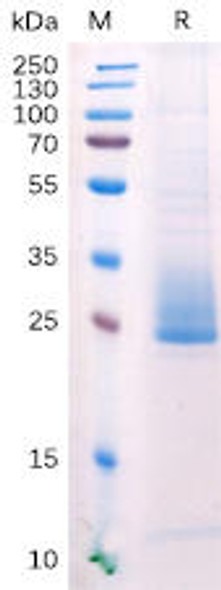Description
| Product Name: | Human ANGPTL3 Recombinant Protein |
| Product Code: | RPPB0036 |
| Size: | 10µg |
| Species: | Human |
| Target: | ANGPTL3 |
| Synonyms: | Angiopoietin 5, ANGPT5, ANGPTL3, Angiopoietin Like Protein 3. |
| Source: | Escherichia Coli |
| Formulation: | ANGPTL3 Human filtered and lyophilized from 0.5 mg/ml in 0.05M Acetate buffer pH-4. |
| Solubility: | Add 0.2 ml of 0.1M Acetate buffer pH-4 and let the lyophilized pellet of ANGPTL3 Human dissolve completely. For conversion into higher pH value, we recommend intensive dilution by relevant buffer to a concentration of 10?g/ml. In higher concentrations the solubility of Angiopoietin 5 is limited. |
| Stability: | Store lyophilized ANGPTL3 Human at -20°C. Aliquot the product after reconstitution to avoid repeated freezing/thawing cycles. Reconstituted Angiopoietin 5 can be stored at 4°C for a limited period of time; it does not show any change after two weeks at 4°C. |
| Purity: | Angiopoietin 5 purity is greater than 95% as determined by SDS-PAGE. |
| Amino Acid Sequence: | MRGSHHHHHH GMASHMSRID QDNSSFDSLS PEPKSRFAML DDVKILANGL LQLGHGLKDF VHKTKGQIND IFQKLNIFDQ SFYDLSLQTS EIKEEEKELR RTTYKLQVKN EEVKNMSLEL NSKLESLLEE KILLQQKVKY LEEQLTNLIQ NQPETPEHPE VTSLKTFVEK QDNSIKDLLQ TVEDQYKQLN QQHSQIKEIE NQLRRTSIQE PTEISLSSKP RAP |
ANGPTL3 and ANGPTL4 are angiopoietin-like proteins secreted and expressed mainly by the liver, their role being the regulation of triglyceride metabolism by inhibiting the lipolysis of triglyceride-rich lipoproteins. During different nutritional states (feeding/fasting) the levels of the circulating triglycerides are regulated by Angptl3 and Angptl4 through differential inhibition of Lipoprotein lipase (LPL) as shown by the experimental data. The molecular structure of ANGPTL3 is similar to that of the angiopoietins (vascular endothelial growth factors). Deletion mutants of human Angiopoietin 5 were used in order to demonstrate that the N-terminal domain (fragment 17-207) and not the C-terminal fibrinogen-like domain (fragment 207-460) increased the plasma triglyceride levels in mice.
The ANGPTL3 Human Recombinant is produced with N-terminal fusion of His-Tag. The Angiopoietin-like protein 3 His Tagged Fusion Protein is 26kDa containing 207 amino acid residues of the ANGPTL3 Human (26-233 a.a.) and 16 additional amino acid residues � His-Tag (underlined).
| UniProt Protein Function: | ANGPTL3: Defects in ANGPTL3 are the cause of familial hypobetalipoproteinemia type 2 (FHBL2); also called combined hypobetalipoproteinemia familial. FHBL2 is a disorder of lipid metabolism characterized by less than 5th percentile age- and sex-specific levels of low density lipoproteins, and dietary fat malabsorption. Affected individuals present with combined hypolipidemia, consisting of extremely low plasma levels of LDL cholesterol, HDL cholesterol, and triglycerides. |
| UniProt Protein Details: | Protein type:Secreted; Cell adhesion; Inhibitor; Motility/polarity/chemotaxis; Secreted, signal peptide Chromosomal Location of Human Ortholog: 1p31.3 Cellular Component: extracellular space; cell surface Molecular Function:integrin binding; enzyme inhibitor activity; phospholipase inhibitor activity; growth factor activity Biological Process: integrin-mediated signaling pathway; cholesterol metabolic process; phospholipid catabolic process; glycerol metabolic process; cell-matrix adhesion; lipid homeostasis; positive regulation of lipid catabolic process; fatty acid metabolic process; signal transduction; sequestering of lipid; positive regulation of angiogenesis; cholesterol homeostasis; acylglycerol homeostasis; phospholipid metabolic process; artery morphogenesis; negative regulation of lipoprotein lipase activity; positive regulation of cell migration; phospholipid homeostasis Disease: Hypobetalipoproteinemia, Familial, 2 |
| NCBI Summary: | This gene encodes a member of a family of secreted proteins that function in angiogenesis. The encoded protein, which is expressed predominantly in the liver, is further processed into an N-terminal coiled-coil domain-containing chain and a C-terminal fibrinogen chain. The N-terminal chain is important for lipid metabolism, while the C-terminal chain may be involved in angiogenesis. Mutations in this gene cause familial hypobetalipoproteinemia type 2. [provided by RefSeq, Aug 2015] |
| UniProt Code: | Q9Y5C1 |
| NCBI GenInfo Identifier: | 25008126 |
| NCBI Gene ID: | 27329 |
| NCBI Accession: | Q9Y5C1.1 |
| UniProt Related Accession: | Q9Y5C1 |
| Molecular Weight: | ~ 54kDa |
| NCBI Full Name: | Angiopoietin-related protein 3 |
| NCBI Synonym Full Names: | angiopoietin like 3 |
| NCBI Official Symbol: | ANGPTL3�� |
| NCBI Official Synonym Symbols: | ANL3; ANG-5; FHBL2; ANGPT5�� |
| NCBI Protein Information: | angiopoietin-related protein 3 |
| UniProt Protein Name: | Angiopoietin-related protein 3 |
| UniProt Synonym Protein Names: | Angiopoietin-5; ANG-5; Angiopoietin-like protein 3 |
| Protein Family: | Angiopoietin-related protein |
| UniProt Gene Name: | ANGPTL3�� |
| UniProt Entry Name: | ANGL3_HUMAN |










